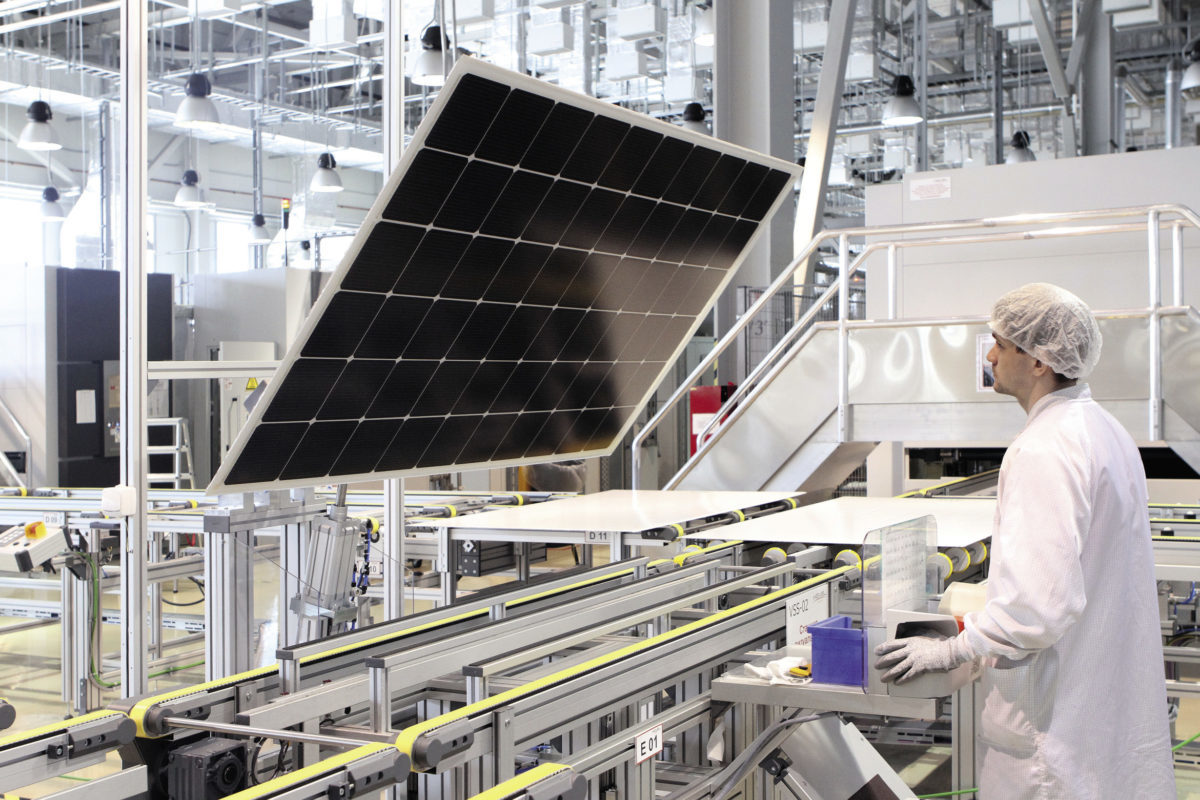From pv magazine, June edition
Russia is the somewhat unlikely location for one of the most experienced heterojunction (HJT) PV production outfits in the post-Panasonic era. Hevel Solar has been ramping up and operating a 180 MW HJT, SmartWire cell and module line in Novocheboksarsk, Russia over the past two years. It is currently adding a second 120 MW line – on which production has just begun.
“The expectations for the HJT modules from the market are extremely high,” says Dmitriy Andronikov, the Chief Process Engineer at Hevel. “HJT modules should provide maximal power. It is certainly a premium product.” Hevel’s 60 cell HJT, SmartWire modules rolling off its lines with an average module power of 320 W. On its new line, Hevel will be producing 72 cell, glass-glass modules and Andronikov anticipates achieving initial outputs around 380 W at STC. “It is just a rough guess as we have just made samples for reliability testing,” he explains.
On the new line, Hevel is also using a new approach to cell interconnection technology – five busbars fixed in place via electrical conductive adhesive (ECA). The approach, says Andronikov, is somewhat better suited to glass-glass encapsulation than SmartWire, and it also provides the manufacturer with technological diversification when it comes to cell interconnection. “We have decided to try the second option to minimise the risks,” he says. Andronikov emphasizes that the move is not a shift away from SmartWire for Hevel but complements it, and the company’s original 180 MW line will continue to deploy the Meyer Burger technology.
ECA interconnection tooling
Hevel has installed two of German equipment supplier teamtechnik’s new TT1600ECA tools on the new line. Four TT14000ECA have also been provided to an Italian manufacturer, presumably Enel, as it fires up its 3Sun HJT facility. The tool was unveiled in April, and it was on display for the first time at last month’s Intersolar Europe show in Munich – in a virtual sense. Speaking before the show, Sven Kramer, teamtechnik’s Vice President Sales e-Solutions, said that given increasing activity in the HJT space, he expected a lot of interest.
“Many people are looking at HJT for well known reasons and ECA is the right solution: higher power, higher quality, longer [module] lifetimes,” said Kramer. “And of course, HJT cells cannot be soldered.”
HJT requires low temperature processes during production, including cell interconnection. This means that conventional soldering techniques are not suitable. HJT equipment supplier Meyer Burger reports that this is because excessive heat transforms the microcrystalline amorphous silicon (a-Si) structure, compromising its passivation characteristics. A spokesperson for the Swiss toolmaker says that while the a-Si can tolerate temperatures of up to 250°C for a short time, “anything over 200°C has a negative impact on the quality of the a-Si layers.” Hence the suitability of both SmartWire, but also the ECA ‘gluing’ process.
Cell interconnection with ECA involves the material being applied to the cells as a paste, with a process temperature of 150°C to 180°C. For this, teamtechnik has deployed a screen printing process, “a proven process also used in cell manufacturing,” notes Kramer. The busbars, four to five being the default number on the TT1600ECA, are then fixed into position as the ECA cures, rather than solders. This, too, brings with it advantages.
Continuously structured busbars
“We use here continuously structured ribbons for the interconnection, LCR [light capturing] ribbon, with the scattered light reflection increasing the power output by around two percent,” says Kramer. Teamtechnik has thus far collaborated with Austrian materials supplier Ulbrich for the LCR. Whereas with soldered busbars sequential structured ribbons must be used, with tin coated areas required for the solder points, this is not required for ECA. With the continuously structured LCR, the ribbon cost is reduced and the stringer’s throughput is higher. “LCR with ECA has no impact on throughput of the stringer but a higher module output will be achieved.”
The TT16000ECA uses many of the same processes as the proven teamtechnik stringing platform, including automated optical inspection, gentle cell handling, and its patented hold down device for ribbon placement and positioning, but it does represent somewhat of a step change for high-efficiency cell interconnection. Additionally, there is an environmental kicker.
“The ECA technology is lead-free,” says Kramer. “If there is a change in [EU] regulations [regarding lead in PV modules] this is definitely a technology to meet this requirement.” The EU Electronics Directive, RoHS 2, currently exempts PV.
While at present, ECA for PV applications is not cheap due in part to its embedded silver content, the number of suppliers is growing, as are their volumes. The silver in the ECA can also functionally replace the silver content currently used in cell metallization – for busbarless cells. The process is slower than traditional busbar soldering, with the TT16000ECA boasting 1,600 cycles per hour, compared to 2,100 on the TT2100, but there are hopes that curing times can be reduced.
“What is also quite good for the ECA technology compared to other technologies used in HJT module production, [is that] there are lots of alternatives and process windows, different materials, and screen layouts, so customers are much more free to generate their own process,” adds teamtechnik’s Solar Sales Manager Michael Essich.
Hevel is not already using the ECA cell interconnection as a replacement for cell metallization, but it is on their technology road map. “Whenever the ECA is cheaper than the silver metallization paste there are cost reductions compared to conventional busbar technology,” says Hevel’s Andronikov. “And the ECAs should become cheaper with larger volume production.”
By Jonathan Gifford
This content is protected by copyright and may not be reused. If you want to cooperate with us and would like to reuse some of our content, please contact: editors@pv-magazine.com.








By submitting this form you agree to pv magazine using your data for the purposes of publishing your comment.
Your personal data will only be disclosed or otherwise transmitted to third parties for the purposes of spam filtering or if this is necessary for technical maintenance of the website. Any other transfer to third parties will not take place unless this is justified on the basis of applicable data protection regulations or if pv magazine is legally obliged to do so.
You may revoke this consent at any time with effect for the future, in which case your personal data will be deleted immediately. Otherwise, your data will be deleted if pv magazine has processed your request or the purpose of data storage is fulfilled.
Further information on data privacy can be found in our Data Protection Policy.